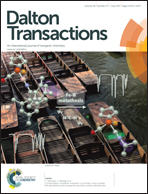Structural and magnetic studies on three new mixed metal copper(ii) selenites and tellurites†
Abstract
Three new transition metal copper(II) selenites or tellurites, namely, CdCu(SeO3)2 (1), HgCu(SeO3)2 (2), and Hg2Cu3(Te3O8)2 (3), have been obtained by conventional hydrothermal reactions of CdO (or Hg2Cl2), CuO and SeO2 (or TeO2). Compounds 1 and 2 are isostructural and crystallize in P21/c. Their structures feature a 3D anionic framework of Cu(SeO3)22− with 1D channels of eight-membered rings (MRs) along the c-axis and a-axis, respectively, which are filled by Cd2+ or Hg2+ cations. Compound 3 crystallizes in a tetragonal system of space group P4212. Its structure is characterized by a [Cu3(Te3O8)2]2− honeycomb layer composed of [Te3O8]4− anions interconnected by Cu2+ ions with 1D channels of 8-MRs along the c-axis. TOPOS analysis indicates that the copper(II) tellurite layer exhibits a new topological structure with a Schläfli symbol of {46·89}2{46}3. The above anionic copper(II) tellurite layers are further linked by dumbbell Hg22+ cations to form a novel 3D framework. Magnetic measurements based on magnetic susceptibility and heat capacity indicate that compounds 1 and 2 show a spin-singlet ground state with a spin gap based on the [Cu2O8]12− dimeric model, whereas compound 3 exhibits a 2D spin-system with an antiferromagnetic ordering around 25 K correlated with its honeycomb [Cu3(Te3O8)2]2− layer. Furthermore, crystalline structures, thermal stabilities, IR spectra and UV-Vis diffuse reflectance spectra have also been studied.


 Please wait while we load your content...
Please wait while we load your content...